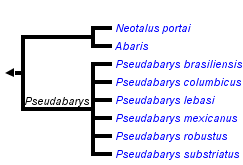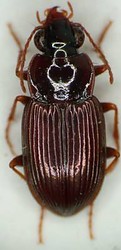Abariform clade
Kipling Will


This tree diagram shows the relationships between several groups of organisms.
The root of the current tree connects the organisms featured in this tree to their containing group and the rest of the Tree of Life. The basal branching point in the tree represents the ancestor of the other groups in the tree. This ancestor diversified over time into several descendent subgroups, which are represented as internal nodes and terminal taxa to the right.

You can click on the root to travel down the Tree of Life all the way to the root of all Life, and you can click on the names of descendent subgroups to travel up the Tree of Life all the way to individual species.
For more information on ToL tree formatting, please see Interpreting the Tree or Classification. To learn more about phylogenetic trees, please visit our Phylogenetic Biology pages.
close boxIntroduction
Members of the primarily Neotropical genera Pseudabarys, Neotalus and Abaris are relatively small ground beetles. Most individuals are brilliantly metallic with very prominent eyes. These characteristics give them a unique look that is very similar to the Australian genus Prosopogmus.
A few of the abariform species have been treated taxonomically. Straneo (1939) published a key to the eight then named species of Abaris and Bousquet (1984) added a ninth species when he discovered that LeConte’s Pterostichus splendidulus belonged in the genus Abaris. Bousquet and Liebherr (1994) summarized what little had been published on the relationships of the genus Abaris and covered nearly all the genera included herein. Will (2002) revised Abaris and Neotalus, providing a key to species and biogeographic analysis for the group.
Characteristics
Included taxa have characteristics of Euchroina and very prominent eyes. Abaris species are uniquely characterized among all Pterostichine grade taxa by pectinate claws.
The combination of large eyes, pectinate claws, and metallic luster suggests that Abaris species may have peculiar life histories or behaviors relative to related genera that have characteristics more typical for pterostichine grade taxa. However, the limited field observations for these species do not provide incontrovertible evidence for any adaptive significance for this suite of characteristics. Both Abaris and Pseudabarys are collected in leaf litter, sometimes in or near fallen rotten fruits or flower petals.
References
Bates, H. W. 1871. Notes on Carabidae, and descriptions of new species (no.1). Entomologist's Monthly Magazine 7.
Bousquet, Y. 1984. Redescription of Abaris splendidula (Leconte) new combination (Coleoptera: Carabidae: Pterostichini). The Coleopterists Bulletin 38:384-389.
Bousquet, Y., and J. K. Liebherr. 1994. Larval description of Abaris bigenera Bates, 1882, and notes on relationships of the genus Abaris Dejean, 1831 (Coleoptera: Carabidae: Pterostichini). Journal of the New York Entomological Society. 102:435-441.
Chaudoir, M. d. 1873. Matériaux pour servir á l'étude des féroniens. Bull. Soc. Imp. Nat. Moscou 46:85-116.
Dejean, P. F. M. A. 1825-1831. Species général des Coléoptéres de la collection de M. LeComte Dejean, Mequignon-Marvis, Paris.
LeConte, J. L. 1863. New species of North American coleoptera. Smithsonian Miscellaneous Collection 167:1-86.
Straneo, S. 1939. On the genus Abaris Dej. (Coleoptera: Carabidae). Psyche 46:38-41.
Will, K. W. 2002. Revision of the new world abariform genera Neotalus n. gen. and Abaris Dejean (Coleoptera: Carabidae: Pterostichini (Auctorum). Annals of the Carnegie Museum of Natural History 71:143-213.
Title Illustrations

| Scientific Name | Abaris aenea |
|---|---|
| Identified By | K.Will |
| Life Cycle Stage | Adult |
| Body Part | Habitus |
| View | Dorsal |
| Image Use |
 This media file is licensed under the Creative Commons Attribution License - Version 3.0. This media file is licensed under the Creative Commons Attribution License - Version 3.0.
|
| Copyright |
© Kipling Will

|
About This Page
Kipling Will

University of California, Berkeley, California, USA
Correspondence regarding this page should be directed to Kipling Will at
Page copyright © 2006 Kipling Will
 Page: Tree of Life
Abariform clade.
Authored by
Kipling Will.
The TEXT of this page is licensed under the
Creative Commons Attribution License - Version 3.0. Note that images and other media
featured on this page are each governed by their own license, and they may or may not be available
for reuse. Click on an image or a media link to access the media data window, which provides the
relevant licensing information. For the general terms and conditions of ToL material reuse and
redistribution, please see the Tree of Life Copyright
Policies.
Page: Tree of Life
Abariform clade.
Authored by
Kipling Will.
The TEXT of this page is licensed under the
Creative Commons Attribution License - Version 3.0. Note that images and other media
featured on this page are each governed by their own license, and they may or may not be available
for reuse. Click on an image or a media link to access the media data window, which provides the
relevant licensing information. For the general terms and conditions of ToL material reuse and
redistribution, please see the Tree of Life Copyright
Policies.
- First online 07 July 2006
- Content changed 21 October 2006
Citing this page:
Will, Kipling. 2006. Abariform clade. Version 21 October 2006 (under construction). http://tolweb.org/Abariform_clade/51566/2006.10.21 in The Tree of Life Web Project, http://tolweb.org/







 Go to quick links
Go to quick search
Go to navigation for this section of the ToL site
Go to detailed links for the ToL site
Go to quick links
Go to quick search
Go to navigation for this section of the ToL site
Go to detailed links for the ToL site